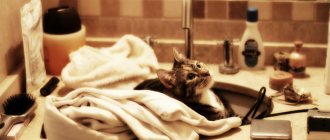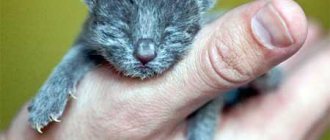Often cats suddenly develop health problems, and the owner does not know what to do or how to help the pet. If the cat cannot go to the toilet in a small way, then, of course, you need to quickly contact a veterinarian. In our article we will try to explain in more detail the problems of this disease, what the causes of this condition may be, and how to provide all possible help to your pet.
How much should a cat urinate normally?
Before moving on to the description of deviations, it is important to mention the recommended standards. Changes in the usual volume of urine and the frequency of trips to the toilet will tell you about the pathology.
Volumes
The exact indicator is determined individually based on the following factors:
- Type of food.
When feeding “natural” food, the body receives not only clean water, but also liquids from foods. This is reflected in the volume of allocations.
- Weight.
Obese animals have less bladder control, so their litter box needs to be changed frequently.
- Age.
Unlike an adult, a kitten is simply not able to make a puddle that is too large due to its size.
- Floor.
During pregnancy, a cat pees more than a cat due to constant pressure on the uterus.
On average, the volume of liquid coming out is 50-200 ml. It can be measured with a measuring cup, after removing all the filler from the tray in advance.
Frequency
Before puberty, kittens pee up to 5 times a day. With age, the frequency of urination decreases by 1-3 times.
The number of trips to the toilet periodically increases during estrus and pregnancy - or remains at the kitten level after castration. In the absence of other alarming symptoms, both phenomena are completely normal.
What to do?
Choosing the right algorithm of action if the cat did not write much the day before is not so difficult.
© shutterstock
Self-treatment
First, you need to remember everything that happened to her in recent days. Perhaps you transported your pet from one place of residence to another? Probably the cause of all the troubles is increased nervous tension. In this situation, you should ensure that your cat is as comfortable as possible. If the tray has been dry for the second day, and the cat periodically comes up and sadly paws at the litter, it may not be entirely comfortable for him in his own toilet. The fact is that if proud cats don’t like something, they will endure it on principle. Perhaps the tray has not been cleaned for a long time or there is not enough filler in it.
Try tidying up or adding pellets to the toilet. Also check to see if your cat is thirsty. Has the water decreased since the last time you filled the bowl? If not, you should force the cat to drink.
What symptoms should you be wary of?
In addition to urinary retention itself, accompanying symptoms can indicate the presence of a problem. These include:
- apathy and depression;
- severe thirst, deterioration or loss of appetite;
- abdominal growth not associated with obesity or pregnancy;
- increased body temperature;
- sleep disturbance;
- swelling of the paws and neck;
- vomiting and diarrhea;
- bending of the hind legs, their uncharacteristic stretching or the appearance of convulsions.
If you notice at least a few of the listed symptoms, you should contact your veterinarian. Otherwise, the cat risks dying from intoxication with decay products.
Diagnostic methods
Without an accurate diagnosis, starting treatment is prohibited. It is important to conduct a full examination of the cat in a clinical setting before drawing up a treatment plan. Remember that even a veterinarian will not be able to reliably find out the pathology, its form and degree of development at home. Clinical examination, laboratory, ultrasound, X-ray examinations are required:
- The sound is determined by lightly tapping the abdomen (percussion) - normally it should be ringing. Palpation allows you to feel a full bladder.
- An x-ray and ultrasound reveal a dark formation of considerable size - this is a full bladder. If we are talking about anuria, then it will be empty, but greatly enlarged kidneys with signs of necrosis will be found.
- A computed tomogram is used in addition to ultrasound for a more detailed study of stones, tumors, and hyperplasia that lead to compression of the urinary tract.
- Urine examination (in case of acute retention, it is taken through catheterization) is necessary to identify infection, pus, blood impurities, as well as determine the type of stones in urolithiasis.
- A blood test is needed to assess the general condition of the cat, the presence of an inflammatory or intoxication process.
After a long (more than a day) delay in urination, it is better to leave cats for several days in the clinic’s hospital, so that if the exacerbation recurs, an emergency ultrasound can be performed, a catheter placed, or an IV with the necessary medications installed.
How to understand that an animal has urinary retention
Urinary dysfunction is very easy to diagnose yourself. Due to an overcrowded bladder, the cat experiences severe pain, and the urine itself changes its color and consistency.
Main symptoms include:
- aggression when palpating the abdomen;
- reducing the volume of urine and increasing the frequency of trips to the toilet;
- leaving puddles or small droplets outside the tray (due to pain, the cat avoids the tray and sits down to relieve itself throughout the house);
- frequent licking of the genitals;
- the appearance of mucus, pus or blood in the urine, as well as a change in its odor.
There is no point in scolding your pet at this time. Your negative reaction will only worsen his condition due to stress. The former cleanliness will return immediately after recovery, so just concentrate on eliminating the problem.
Can cats stop peeing at night?
Since cats can hold their urine for up to 48 hours, it is no problem for them not to pee at night. However, this should not be a reason for you not to have a litter box in your home! Indoor cats should always have access to a litter box.
It is very dangerous if your cat stops urinating, so don't hesitate to take her to the vet if you notice any problems or changes in routine. The sooner you give your cat the treatment it needs, the easier it will be to treat it.
Article Author: Roland Jacob Roland has been an animal lover all his life, and cats have a special place in his heart. He is owned by three felines: Willie, KitzKitz and Nugget (all rescues), who bring all the laughter and mischief you would expect from a race of cat owners.
What disorders cause difficulty urinating?
Depending on the existing disorder, urine is completely or partially absent - or it encounters an obstruction at the exit. In the first case, the cause usually lies in renal pathologies, and in the second, in blockage of the urethra due to excitement, trauma, infections and stones.
Sexual arousal
Most often, during sexual hunting, owners complain about the opposite problem - frequent urination in females and leaving marks in males. But excitement also leads to enlargement of the gonads with subsequent compression of the urethra.
Injuries
After an accident and falling from a height, a cat can damage its internal organs. In this case, the delay is explained by the loss of their functionality, and the presence of blood in the urine is due to internal bleeding.
Cystitis and other bladder diseases
The most common reason why a cat cannot pee is cystitis. Inflammation in the bladder is usually caused by bacteria that enter there directly or from neighboring organs. The pathology is accompanied by severe pain, increased urge and a gradual reduction in the volume of fluid to a few drops.
Advanced cystitis is often complicated by urethritis. With this disorder, the inflammatory process covers the urethra. It can be diagnosed by purulent discharge and a strong odor of acetone or ammonia from the pet's skin.
Urolithiasis disease
When there are too many stones in the ureter, a blockage occurs. Every attempt to urinate is accompanied by acute pain due to stones that injure the delicate mucous membrane. The blood emerging from numerous wounds turns the urine pink or comes out in separate clots.
“
Read more about urolithiasis in cats
Renal pathologies
Of all the kidney diseases in cats, kidney failure is the most common. It occurs when there is blockage and compression of the urinary tract, a sharp decrease in the amount of blood circulating through the kidneys, and direct dysfunction of the organ. The last case has the most unfavorable prognosis, since damaged kidney cells are not able to recover.
The main signs of the disease
The main sign that a cat cannot pee is when the animal walks around the tray and meows pitifully. Some owners notice that their pets sometimes behave in this way during heat. But you should distinguish between these reasons in order to promptly help a cat who cannot go to the toilet in a small way at home.
A sick pet exhibits the following clinical signs:
- depressed state;
- unnatural posture with an arched back, a bent neck and knees pushed forward;
- enlargement of the abdomen due to a full bladder;
- decreased or lack of appetite;
- increased body temperature;
- plaintive meowing or screaming during sudden attacks of pain.
If the cat begins to pee a little, then you should pay attention to the quality of the urine. It may change from a light yellow color to an orange or brown tint due to the presence of blood cells. Also, the urine will emit an unpleasant purulent odor, and its structure will become grainy due to crystalline inclusions or sand.
Note! Sometimes a sign that your cat can't pee is stretching out its back legs and licking the genital area for a long time. Also, if it is painful for a cat to go to the toilet in a small way, he lies down near the tray and meows pitifully, demonstrating his problem to the owner.
First aid: what to do if the cat cannot pee?
Veterinarians recommend not to self-medicate and seek help immediately. Otherwise, there is a risk of worsening the condition due to incorrect selection of the drug and its dosage.
You can provide first aid only when you are unable to deliver your cat to a veterinary clinic in the near future. But even in this case, you need to contact the doctor at least by phone in order to receive detailed instructions from him.
Acceptable Actions
If you do not have sufficient experience in palpation and massage, then it is better to avoid these actions. Too much squeezing can cause injury to the mucous membrane and even rupture of the bladder.
A cat showing signs of thirst can be given some water from a dropper or light chicken broth. But you shouldn’t force drink. In case of renal failure, this will increase swelling and create additional stress on the overcrowded organ.
“ Kind words and not too active games will contribute to a temporary improvement in the condition. They will help distract you and reduce accompanying symptoms.
On the recommendation of a doctor, you can give an antispasmodic or pain reliever. They will help eliminate urethral spasm and pain.
Prohibited actions
If your cat has problems with urination, then under no circumstances use warming compresses. In case of intoxication, additional heat will only accelerate the spread of infection.
It is also prohibited to give medications without first obtaining advice. Antispasmodics increase bleeding, and diuretics increase the volume of internal fluid. To prescribe them, it is necessary to know the exact or at least presumptive diagnosis made by a veterinarian.
Prevention measures
After treatment, the owner must adhere to the following recommendations to prevent exacerbations:
- Strictly follow all doctor's instructions and do not give your kitten medications at your own discretion.
- Stop feeding your pet fish, raw meat, salted, smoked, spicy and fatty foods.
- Together with your veterinarian, select a special food for kittens that have problems with the urinary tract.
- Provide the kitten with constant access to clean drinking water or switch to liquid food.
- Take urine and blood tests, do an ultrasound of the urinary tract once every 6 months.
- Control physical activity: do not allow the kitten to sleep constantly, but do not overexert it.
- Carefully monitor the animal’s weight to prevent the development of obesity.
- Avoid overheating, hypothermia, injury and stressful situations.
- Use a special filler for the tray that reacts to changes in urine acidity.
If a kitten has problems with urination, a loving and observant owner should immediately contact a veterinarian. This will avoid complications, because urinary tract diseases are easier to treat at the initial stage of their development.











